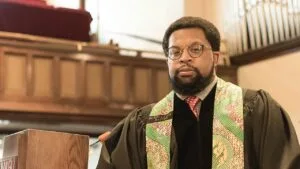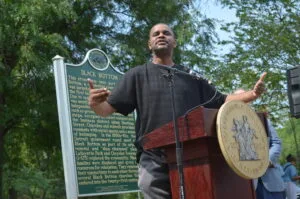September represents International Underground Railroad Month and several Michigan-based institutions, organizations and individuals continue to share the story of abolitionists, slaves and others.
“The Underground Railroad was not a physical railroad. It was a network of people across racial identities who helped people fleeing enslavement,” the Michigan’s History Center writes on its website.
Canada, where slavery was outlawed beginning in 1834, was a destination place for Black Americans during that period. It was about three decades before America’s Emancipation Proclamation in 1863.
Jamon Jordan, city of Detroit historian, told the Michigan Advance that the city’s proximity to Canada made the Motor City an important destination for Black slaves.
“There were some radical African Americans and some white allies who were highly opposed to slavery and they were very active in this area,” said Jordan, a Detroit resident who operates history tours business and teaches at the University of Michigan. Many of his tours include Detroit Underground Railroad sites.
Because of the Fugitive Slave Act of 1850, slaves captured in the northern U.S. could still be sent back to their slave owners.
The Detroit “stations” were essential in the path toward freedom because of its close proximity to Canada.
One of them was Second Baptist Church, Michigan’s oldest Black congregation, which was founded in 1836. Slaves were held there in the basement under the church’s sanctuary until they could continue their journey to Canada.
Today, the church offers tours of the institution to the public led by the Rev. Lawrence Rodgers.
The Underground Railroad Living Museum Flight to Freedom Tour is a “storytelling” reenactment of the original Underground Railroad passage that operated between 1840 and 1863. It is led by Historic First Congregational Church of Detroit.
Detroit’s Gateway to Freedom International Memorial statute is perhaps the most popular visual representation of the Underground Railroad era in the Motor City. Dedicated in 2001, it is located in Hart Plaza on the city’s riverfront. Ed Dwight, an African American sculptor, designed the statue.
Several Black and white people were prominent Underground Railroad “conductors.” They included Seymour Finney, a white Detroit businessman and George DeBaptiste, an African American businessman. Black and white residents founded the Detroit Anti-Slavery Society in 1837.
“Detroit was one of the most critical stops on the Underground Railroad, because it was generally the final stop before achieving freedom,” the Detroit Historical Society writes on its website. “There are at least seven known paths that led freedom seekers from various points in Michigan to the Canadian shore and it is estimated that 200 Underground Railroad stops existed throughout Michigan between the 1820s and 1865. The Underground Railroad ended in 1865 with the end of the Civil War and the 13th Amendment abolishing slavery.”
In Battle Creek, a statue stands that lifts the abolitionists effort of Sojourner Truth, who lived in Michigan during her final years. The former slave and women’s rights advocate died on Nov. 26, 1883. She is buried in Battle Creek’s Oak Hill Cemetery.
The Michigan Freedom Trail Commission “preserves, protects and promotes the rich legacy of the Underground Railroad and the antislavery movement in Michigan,” according to its website. Jordan is a member of the commission.
The commission plans to offer on Saturday its “Heritage Gathering,” an annual fall series of virtual and in-person programs.
Kimberly Simmons, an African American author and historian, former Michigan Freedom Trail Commission member and Detroit River Project (DRP) founder, believes that the Michigan and Ontario, Canada, region should be better promoted as the important part of the Underground Railroad story. Simmons is a fifth-generation Underground Railroad descendant of a family that found freedom in the Detroit area in 1835.
“,”infobar”:true,”animationEffect”:false,”animationDuration”:366,”transitionEffect”:false,”transitionDuration”:366,”thumbs”:{“autoStart”:false,”axis”:”y”}},”inView”:false,”email_subject”:”Check out this awesome image !!”,”email_message”:”Here is the link to the image : %%image_link%% and this is the link to the gallery : %%gallery_link%%”,”lightbox”:”direct”,”filterClick”:”0″,”dropdownFilters”:”0″,”defaultActiveFilter”:”all”,”initLightbox”:”modula_pro_init_lightbox”,”haveFilters”:0}”>

Underground Railroad site at Detroit’s Second Baptist Church. Slaves were hidden in the church’s basement until the coast was clear to proceed to Canada. | Ken Coleman

The Rev. Lawrence Rodgers, pastor of Detroit’s Second Baptist Church. His congregation offers tours that share the Detroit Underground Railroad story. | Second Baptist Church photo

Detroit historian Jamon Jordan, Aug. 9, 2021 | Ken Coleman

Gateway to Freedom International Memorial statue in Detroit | Ken Coleman
The DRP, a nonprofit organization, is carrying out an effort to promote the U.S. and Canada for inclusion on the United Nations Educational, Scientific and Cultural Organization (UNESCO) World Heritage Site list.
“We are the centerpiece for freedom and resistance,” Simmons, who has dual citizenship in the U.S. and Canada, told the Advance about the region.
The North Buxton community in Ontario, for example, recently held its annual Underground Railroad celebration. The rural community east of Windsor was established in 1849 as a haven for and by former African-American slaves who escaped to Canada to gain freedom. It is home to a museum that chronicles the history of Black people in Canada.
The community’s history includes Mary Ann Shadd, an anti-slavery activist, journalist, publisher, teacher, and lawyer. Shadd was the first Black woman publisher in North America, according to many accounts.
The celebration held between Sept. 2 and 4 featured a parade and several other community events.
At DRP’s request, then-U.S. Rep. Brenda Lawrence (D-Southfield) and current U.S. Rep. Rashida Tlaib (D-Detroit) in 2021 co-sponsored a resolution affirming the Detroit and Ontario region’s importance in the Underground Railroad story.
“[T]he legacy of African Americans is interwoven with the fabric of democracy and freedom in the United States,” a portion of the resolution read.
GET THE MORNING HEADLINES DELIVERED TO YOUR INBOX



